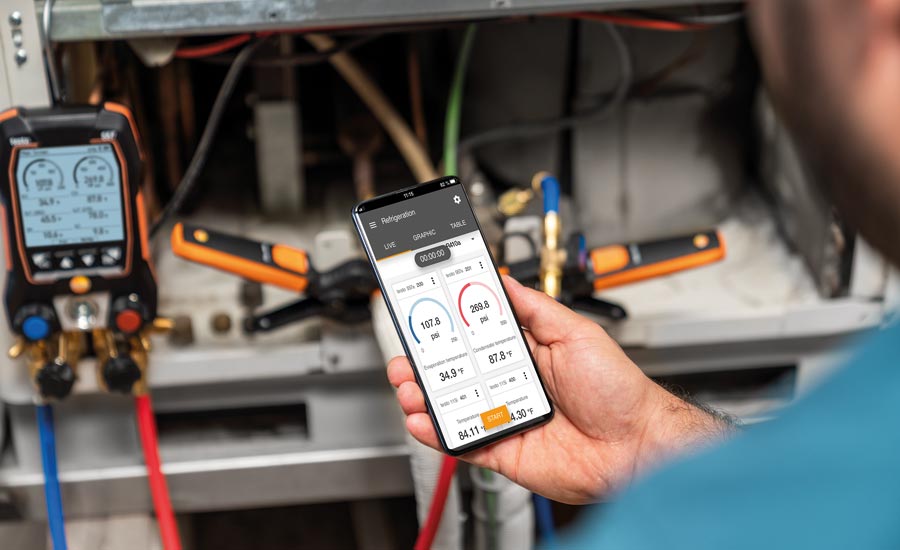Air conditioning and heating systems are perhaps the most consumer-facing products in the HVAC industry, but technicians’ tools are the products that make it all possible. Though end users might not know every tool that a technician uses to install and service an HVAC system, contractors and their employees know how critical having a durable and trustworthy tool is. And just like the rest of the industry, technological developments are consistently improving the tools technicians have to use.
Trends In Tools
Digitalization is the name of the game when it comes to tool technology. Now, tools can communicate with other tools, connect with mobile devices, and store data by utilizing cloud storage. This means that technicians can share instrument data with the home office remotely when in need of additional troubleshooting expertise, and the data for an individual piece of equipment can be stored online. That way, at the next visit to that same piece of equipment (even if it is years later), technicians can pull up the equipment’s history. All of this leads to more accurate system diagnosis, which leads to fewer callbacks and happier customers.
Jim Gregorec, Fieldpiece vice president of research and development engineering, explained that the wireless communication in the Fieldpiece Job Link System means that technicians no longer need to run between the indoor and outdoor equipment. They can gather measurement information, perform manual calculations, and can multitask during certain aspects of the job until an alarm sounds on the tool or their mobile device. Time is saved, and money is earned.
“Digitalization is quickly becoming standard in the HVAC industry, powered by smart instrumentation and app-based connectivity,” said Michael Ficacci, director of marketing, Testo North America. “As part of a service call or installation, technicians are now able to supply and transmit real-time operational data, photographic evidence, and customer information via their instrumentation into their smart device and then into cloud databases for the home office and as a reference anytime in the future.”
He added that intuitive software running in the background of these apps has the ability to recognize what job a technician just drove up to and automatically show all the measurement readings from the initial installation and all service appointment thereafter.
All in all, digitalization of tools means that they are getting lighter, faster, more versatile, and increasingly integrated with smartphones as they move more and more into AI and the Internet of Things.
Tools for Technicians
Technicians want tools that are safe, easy to use, and will get the job done faster. Digitalization certainly plays a role in accomplishing these goals, but new tools incorporate even more.
“We consistently hear from HVAC technicians that they strive for efficiency, as well as only wanting to go to a job site just once — they want to get the job done right the first time,” said Nancy Gunnerson, marketing manager for Malco Products SBC. New tools are eliminating what have long been hassles for the technician. She offered Malco’s C-RHEX drivers as an example, as they combine what traditionally have been two drivers into one, keep screws in place so they don’t fall out, and allow for easy cleaning.
Plus, as green refrigerants grow in popularity in the HVAC industry, safety becomes a top priority, and technicians will need to handle those refrigerants with care. Gregorec said that HVACR tools are becoming A2L compliant to work on mildly flammable refrigerants, helping technicians stay safe.
Modern instruments are getting increasingly accurate and precise, and they are able to collect more data. Technicians find themselves checking superheat, subcool, airflow, CO2 and more, and modern data collection can feed into apps that give technicians recommendations and warnings about the systems being serviced.
“Many digital tools have step-by-step instructions tied to the smartphone, as well as video installations and color coding to show what goes where,” said Gary Lampasona, vice president of sales and marketing at Ritchie Engineering Company Inc. “Calculations are automated in analysis tools and reports are filled in automatically; then they can be sent digitally to the customer or printed.”
Lampasona added that items like the new BLDC motor-driven devices are more efficient and easier to carry, allowing for larger voltage variations. Newer tools are designed to keep technicians safe with locking power cords and sealed components to eliminate sparking in A2L and A3 applications.
Bringing in the Next Generation
Managers in the office have reason to be excited for new tools — they are making the HVAC industry more accessible for the next generation. Tools are not threatening technicians’ jobs. Rather, they are making room for technicians to be even more efficient and service more customers, and are offering the opportunity to make the industry more exciting. This could even help contractors weather the labor shortage.

CUTTING EDGE: Recruits should be shown how the HVAC industry exposes them to fascinating technology that can both be exciting and contribute to a stable career. (Courtesy of Fieldpiece)
“Potential recruits should be attracted to the many resources available to become a craftsman in a challenging and rewarding field. Technology is advancing to provide consistent comfort with higher energy efficiency and a coordinated support network,” said Gigorec. “Skills training, certification, apprenticing, accurate and efficient smart tools, and coordinated field technical support all work in concert to put a new recruit in the best position to succeed.”
Gunnerson said that the skilled trades used to be viewed as an unattractive career path, but that perspective is shifting. More and more people are seeing the trades as a viable option for a comfortable life and a stable career. Many people do not find a standard nine-to-five desk job to be an interesting or a fulfilling career, especially when it might include taking on a large sum of debt to attend a university.
“Contractors who emphasize the importance of doing a job the right way — meaning doing it safely, efficiently, and well — help inspire pride in the HVAC trade and can be an incredibly positive recruitment tool,” said Gunnerson. “Part of doing the job right is having tools that can stand up to the work over the years and help get the job done more easily and ergonomically.”
Contractors can show potential recruits the cutting-edge technology of the HVAC industry, which can connect to smartphones, allow for system self-diagnosis, and utilize the IoT. Recruits can see how the HVAC industry exposes them to fascinating technology that can both be exciting and contribute to a stable career.





